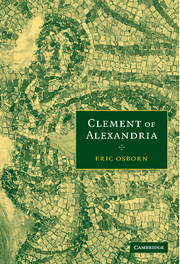Book contents
- Frontmatter
- Contents
- Preface
- List of abbreviations
- 1 Life and works
- PART I DIVINE PLAN/ECONOMY
- 2 Divine plan/economy and mobility
- 3 Scripture
- 4 Philo and Clement: from Divine Oracle to True Philosophy
- PART II DIVINE RECIPROCITY
- PART III FAITH AND SALVATION
- Conclusion
- Appendix: Irenaeus and Clement
- Select Bibliography
- Subject index
- Citations from Clement
- Citations from the Bible
- Citations from ancient authors
4 - Philo and Clement: from Divine Oracle to True Philosophy
Published online by Cambridge University Press: 06 July 2010
- Frontmatter
- Contents
- Preface
- List of abbreviations
- 1 Life and works
- PART I DIVINE PLAN/ECONOMY
- 2 Divine plan/economy and mobility
- 3 Scripture
- 4 Philo and Clement: from Divine Oracle to True Philosophy
- PART II DIVINE RECIPROCITY
- PART III FAITH AND SALVATION
- Conclusion
- Appendix: Irenaeus and Clement
- Select Bibliography
- Subject index
- Citations from Clement
- Citations from the Bible
- Citations from ancient authors
Summary
We have just seen how Clement moved from narrative to metaphysic by means of parable or metaphor. Philo faced the same problem. Just as Christians began from a recital of events – the birth, life, suffering and death and resurrection of Jesus – so Jews centred their faith on the events of the wandering Aramaean who went down into Egypt, was afflicted and delivered through Moses to Sinai. The narrative section of the Fourth Gospel has been called the ‘book of signs’ because the events point to the cross which dominates the Gospel; similarly for Philo, the events of the Pentateuch point to the revelation of the law on Sinai.
The relation between Philo and Clement raises many questions and a variety of answers. Fortunately, the problem is now more accessible through two magisterial works. In the first, evidence is assembled and the wider question of Philo's adoption by early Christian writers illuminated. For Clement, two positions are set out: some writers maximise while others minimise the debt of Clement to Philo. A third position is adumbrated. Clement knew Plato and the bible; Philo showed him how they could fit together. ‘Philo did not teach Clement Platonism, but rather how to connect his Platonism to biblical thought, and specifically to biblical exegesis, above all through the use of allegory.’
- Type
- Chapter
- Information
- Clement of Alexandria , pp. 81 - 106Publisher: Cambridge University PressPrint publication year: 2005



